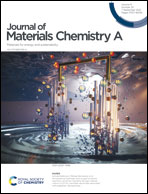Carbon black nanoparticle trapping: a strategy to realize the true energy storage potential of redox-active conjugated microporous polymers†
Abstract
Conjugated microporous polymers (CMPs) have significant potential as electrode materials for electric energy storage devices due to their high surface areas, conjugation features, and chemical stability. However, low conductivity has limited their electrochemical performance. To realize the maximum capability of CMPs, a synthetic strategy for enhancing their conductivity is required. This work shows that during the synthesis of CMPs, carbon black (CB) nanoparticles can be entrapped in situ. Moreover, redox-active benzoquinone (BQ) species could be generated at the CMP to form CMP-BQ through post-synthetic modification. The resultant CB@CMP-BQs with the entrapped CB nanoparticles showed enhanced electrochemical performance as electrode materials for pseudocapacitors, compared with CMP-BQ. They showed capacitances up to 424 and 373 F g−1 at current densities of 0.5 and 1 A g−1, respectively. In addition, the optimal CB@CMP-BQ3 showed excellent cycling performance for 10 000 cycles.



 Please wait while we load your content...
Please wait while we load your content...